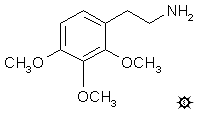
#91 IM
ISOMESCALINE; 2,3,4-TRIMETHOXYPHENETHYLAMINE
|
| [3D .mol structure] |
A solution of 4.0 g LAH in 80 mL THF under He was cooled to 0 °C and vigorously stirred. There was added, dropwise, 2.7 mL of 100% H2SO4, followed by a solution of 4.7 g 2,3,4-trimethoxy-beta-nitrostyrene in 40 mL anhydrous THF. The mixture was stirred at 0 °C for 1 h, at room temperature for 1 h, and then brought briefly to a reflux on the steam bath. After cooling again, the excess hydride was destroyed with 4.7 mL H2O in THF, followed by the addition of 18.8 mL 15% NaOH which was sufficient to convert the solids to a white and granular form. These were removed by filtration, the filter cake washed with THF, the mother liquor and filtrates combined, and the solvent removed under vacuum. The residue was added to dilute H2SO4, and washed with 2x75 mL CH2Cl2. The aqueous phase was made basic with 25% NaOH, and extracted with 2x50 mL CH2Cl2. The solvent was removed from these pooled extracts and the amber-colored residue distilled at 95-100 °C at 0.3 mm/Hg to provide 2.8 g of 2,3,4-trimethoxyphenethylamine as a white oil. This was dissolved in 20 mL IPA, neutralized with about 1 mL concentrated HCl, and diluted with 60 mL anhydrous Et2O. After filtering, Et2O-washing, and air drying, there was obtained 3.2 g of 2,3,4-trimethoxyphenethylamine hydrochloride (IM) as a white crystalline product.
DOSAGE: greater than 400 mg.
DURATION: unknown.
QUALITATIVE COMMENTS: (with 300 mg) No effects whatsoever.
(with 400 mg) Maybe a slight tingle at the hour-and-a-half point. Maybe not. Certainly nothing an hour later. Put this down as being without action.
EXTENSIONS AND COMMENTARY: Some fifty years ago this material was given the name "reciprocal mescaline" in that it was believed to exacerbate the clinical symptoms in schizophrenic patients. In the original report, one finds: RThus we have discovered an extremely remarkable dependency of the intoxicating action upon the position of the three methoxy groups. Mescaline, the 3,4,5-trimethoxy-beta-phenethylamine, produces in the normal subject a much stronger over-all intoxication than in the schizophrenic patient, whereas 2,3,4-trimethoxy-beta-phenethylamine has quite the opposite effect. It has little action in healthy individuals, being almost without intoxicating properties, but it is very potent in the schizophrenic. The metabolic conversion products of the "reciprocal" mescaline will be further studied as soon as the study of the metabolism of the proper mescaline is complete.
This is a pretty rich offering, and one that the present medical community has no qualms about discarding. At the bookkeeping level, the promised further studies have never appeared, so all may be forgotten as far as potential new discoveries might be concerned.
One recent related study has been reported, tying together isomescaline and schizophrenia. Through the use of radioactive labelling, the extent of demethylation (the metabolic removal of the methyl groups from the methoxyls) was determined in both schizophrenic patients and normal subjects. When there was a loading of the person with methionine (an amino acid that is the principal source of the body's methyl groups), the schizophrenics appeared to show a lesser amount of demethylation.
But might either of these two observations lead to a diagnostic test for schizophrenia? At the present time, the conventional thinking is that this probably cannot be. The illness has such social and genetic contributions, that no simple measure of a response to an almost-psychedelic, or minor shift of some urinary metabolite pattern could possibly be believed. No independent confirmation of these properties has been reported. But maybe these findings are valid. A major problem in following these leads does not involve any complex research protocols. What must be addressed are the present regulatory restrictions and the Federal law structure. And these are formidable obstacles.
| [ |
[Main Index] | [Forward |

